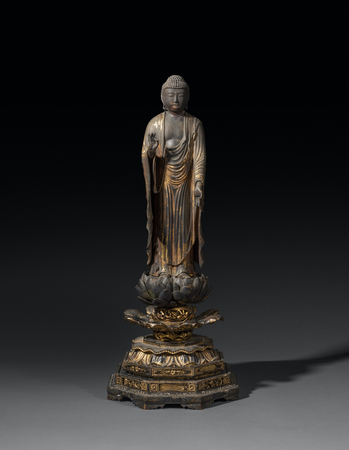Product Description
7235 A gilt-lacquered wood figure of Amida Buddha dressed in a flowing robe, standing on a double-lotus pedestal raised on an elaborately decorated stand
The head has gyokugan (inlaid crystal eyes) and is also adorned with crystals representing the byakugō (white spiralling hair) on the forehead and the nikkei-shu (red jewel on the protrusion on top of the Buddha’s head). The right arm raised and the left arm extended with the forefinger and thumb of each hand forming a circle, which represents the raigōin mudra, welcoming the believer into Amida’s Great Western Paradise. The mandorla is carved with scrolling clouds and a Sanskrit character.
Japan 15th century Muromachi period
Dimensions:
Figure: H. 43.5cm x W. 15cm x D. 12.5cm (17¼” x 6” x 5”)
Figure and stand: H. 69cm x W. 28.5cm x D. 26cm (27¼” x 11¼” x 10¼”)
Figure, stand and mandorla: H. 84cm x W. 28.5cm x D. 26cm (33″ x 11¼” x 10¼”)
Provenance: the collection of Mr Richard Nathanson (d. 2018).
Belief in Amida as Lord of the Western Paradise rose in popularity during the late 10thcentury. Based primarily on the concept of salvation through faith, it was not only a religion which appealed to a broad range of people, but also a direct assertion of piety against the dogmatic and esoteric ritual of the more traditional Tendai and Shingon sects. In Amida’s Western Paradise the faithful are reborn, to progress through various stages of increasing awareness until finally achieving complete enlightenment.
Another factor that engendered faith in Amida was a widespread belief of the Three Periods of the Law known as the Days of the Dharma (the Buddhist teachings). This was an all-encompassing concept of society’s rise and fall that originated in Indian Buddhism and later became widespread in China and Japan. It foretold of the world’s ultimate decay and the complete disappearance of Buddhist practice. At the time, the Days of the Dharma in Japan were divided into three periods. The first phase, the Age of Shōbō, was said to last 1,000 years after the death of the Buddha. It was believed to be a golden period during which followers had the capacity to understand the Dharma. The second phase, the Age of Zōhō, was also to last 1,000 years, during which Buddhist practice would begin to weaken. The third and final phase lasting 3,000 years, the Age of Mappō, was when Buddhist faith would deteriorate and no longer be practiced. In Japan the Age of Mappō was said to begin in 1052 AD, and a sense of foreboding thus filled the land, with people from all classes yearning for salvation leading to a widespread practice of continuously repeating the mantra of Amida Buddha.
This style of Amida Nyorai sculpture is after Annamiyō (Annami-style), which was originated by Kaikei (act. c. 1183-1223) who received a Buddhist name, An-amidabutsu or alliterated Annamidabutsu as a devout believer of Jōdo (Pure Land) sect Buddhism. Kaikei was one of the most important Buddhist sculptors active in the late-Heian to Kamakura period, often compared with another Kei-School great master Unkei (d. 1224). Widely favoured as the ideal embodiment of Amida Nyorai in Japan, Kaikei’s style was carried on and developed by his followers and later generations. Most of the standing Amida figures at and after the time of Kaikei are said to be more or less influenced by his style.
For comparable examples by Kaikei, see:
Nara National Museum ed., The Buddhist Master Sculptor Kaikei: Timeless Beauty from the Kamakura Period, (Nara, 2017), no. 83 (13th century, Daienji temple, Osaka); no. 85 (13th century, Enjōji Temple, Shiga); no. 87 (1221, Kōrinji temple, Nara, Important Cultural Property); p. 156 (1211, Tōjuin temple, Okayama, Important Cultural Property); p.157 (c. 1221, Kōdaiin temple, Wakayama, Important Cultural Property);
Asia Society Museum ed., Kamakura, Realism and Spirituality in the Sculpture of Japan, (New Heaven and London, 2016), p.56-57, no. 4 (c. 1210, Kimbell Art Museum, Texas, no. AP 1984.01 a,b,c)
For other comparable examples see:
Asia Society ed., Kamakura, Realism and Spirituality in the Sculpture of Japan, (New Heaven and London, 2016), p.102, pl.25 and Asia Society ed., The Art of Impermanence: Japanese Works from the John C. Weber Collection and Mr. and Mrs. John D. Rockefeller 3rd Collection, (New York, 2020), p. 90-91, no. 23. (Amida Nyorai, mid-late 13th century, Mr and Mrs John D. Rockefeller 3rd collection);
Tokyo National Museum ed., Tokubetsuten Kamakura-jidai no Chōkoku [Special Exhibition: Japanese Sculpture of the Kamakura Period], exhibition catalogue, (Tokyo, 1975), cat. no. 61. (An Amida Nyorai by Eisen (1239-?), dated 1259, Important Cultural Property, the Tokyo National Museum, C-508); no. 83 (Yakushi Nyorai, dated 1253, Iwaya-ji temple, Ibaraki);
Victor Harris and Ken Matsushima, Kamakura: The Renaissance of Japanese Sculpture 1185-1333, (British Museum, London, 1991), no.16 (Amida Nyorai by Gyōkai, 1235, Amidaji temple, Shiga prefecture, Important Cultural Property).
Radio Carbon Dating Ref: RCD-9441
n.b. There seems to be a small piece broken off at the end of the robes draping from the right hand and smaller but similar damage to the robes below the left arm. The figure has been attached to the lotus base which is usually separate. Both the stand and the mandorla are of a later date, most probably the 17th/18thcentury.










